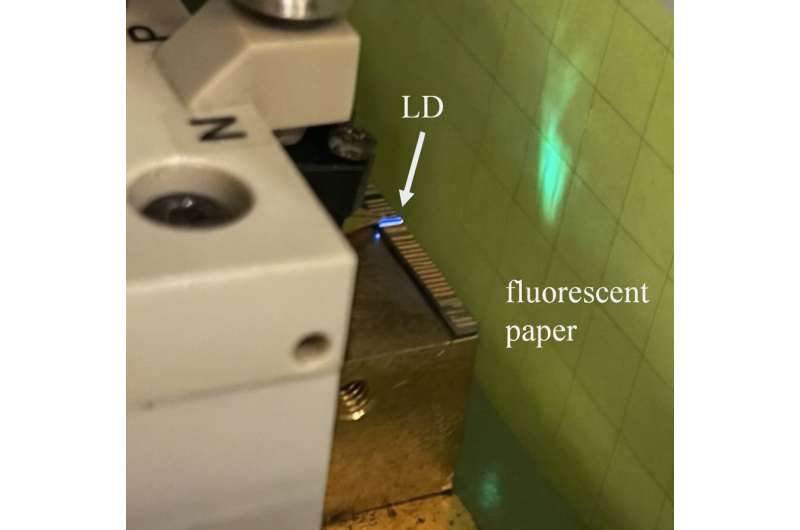This article has been reviewed according to Science X's editorial process and policies. Editors have highlighted the following attributes while ensuring the content's credibility:
fact-checked
trusted source
proofread
Realizing vertical ultraviolet-B semiconductor laser diodes for high optical output

Ultraviolet (UV) rays are electromagnetic waves with wavelengths ranging from 100 to 380 nanometers (nm). These wavelengths can be classified into three regions: UV-A (315–380 nm), UV-B (280–315 nm), and UV-C (100–280 nm), with the latter two comprising deep UV rays.
Laser light sources with emission in the UV region, such as gas lasers and solid-state lasers based on harmonics of yttrium aluminum garnet lasers, find applications in biotechnology, skin disease treatment, UV curing processes, and laser processing. However, these lasers are large and consume a lot of power, besides having limited wavelength range and low efficiency.
In recent years, considerable achievements in fabrication technology have facilitated the development of high-performance semiconductor lasers that generate light by injecting current. These include UV-light-emitting devices based on aluminum gallium nitride (or AlGaN), a semiconductor material. However, their maximum optical output power in the deep UV region is only about 150milliwatt(mW), which is much lower than the power required for medical and industrial applications.
It is crucial to increase the injection current in a device to enhance the output power. This requires increasing the device size, which, in turn, makes it challenging to ensure uniform current flow in the device.
Against this background, a team of researchers from Japan, led by Professor Motoaki Iwaya from the Department of Materials Science and Engineering at Meijo University, has successfully developed high-performance vertical AlGaN-based UV-B semiconductor laser diodes. The study was performed in collaboration with researchers from Mie University, Ushio, Inc., and Seishin Trading Co. Ltd., and was published in Applied Physics Express journal.
Talking about the motivation behind developing these devices, Prof. Iwaya says, "Existing AlGaN-based deep UV lasers utilize insulating materials such as sapphire and AlN to obtain high-quality crystals. Notably, the current flows laterally in these devices. To enhance their light output, we explored vertical devices with p- and n-electrodes facing each other in a p–n junction."
Importantly, vertical configurations have been explored in the past for realizing high-power semiconductor devices. However, advancement of this configuration has lagged for semiconductor lasers and has not yet been realized for AlGaN-based deep-UV light emitting devices.
To this end, the researchers first fabricated high-quality AlN on a sapphire substrate. This was followed by the formation of periodic AlN nanopillars and the deposition of AlGaN-based laser structure.
The team utilized innovative laser lift-off technology based on pulsed solid-state lasers to peel the device structure off the substrate. They also developed a semiconductor process to manufacture electrodes, current confinement structures, and insulating layers necessary for laser oscillation, and a cleavage method using a blade to form an excellent optical resonator.
The vertical AlGaN-based UV-B semiconductor laser diodes thus fabricated have novel and unique characteristics. They operate at room temperature and exhibit an extremely sharp emission at 298.1 nm, a well-defined threshold current, strong transverse-electric polarization characteristic. The researchers also observed a laser-specific spot-like far-field pattern, confirming the device oscillation.
Put together, these results suggest that the fabrication of vertical AlGaN -based devices with a unique structure was achieved by overcoming the existing challenges associated with their fabrication.
"This work demonstrates the operation of a vertical device capable of the high current operation necessary for high-power output. It is expected to pave the way for novel cost-efficient manufacturing processes for electric vehicles and artificial intelligence," concludes Prof. Iwaya.
The researchers hope that vertical AlGaN-based UV lasers find real-life applications in the medical and manufacturing fields.
More information: Toma Nishibayashi et al, Fabrication of vertical AlGaN-based ultraviolet-B laser diodes using a laser lift-off method, Applied Physics Express (2023). DOI: 10.35848/1882-0786/ad03ac
Provided by Meijo University




















